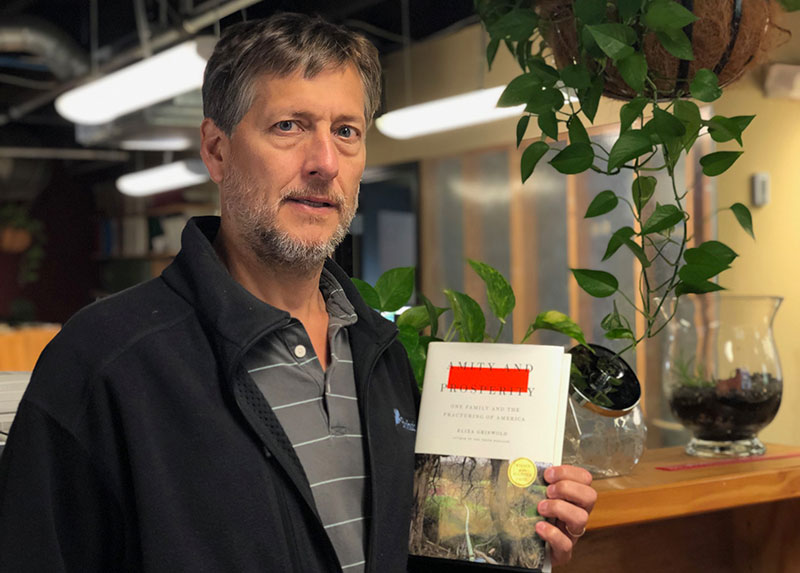Unless you count online news feeds and monthly professional periodicals like Civil Engineering Magazine, I’m not a voracious reader. Truth be told, I rarely finish a book. But when I happened to pick up Eliza Grizwold’s Amity and Prosperity after hearing her give a keynote address at a conference this past May and receiving the book as a registration giveaway, I could not put it down.

The book tells an emotional tale of the complex web of issues surrounding depressed, post-industrial communities, where the ending of centuries-old ways of life has left families searching for ways to carve out an existence and meet basic needs. For many such families, the silver bullet solution comes in the form of land lease payments made by energy corporations in search of natural gas sources in the shale and other formations. This was the case for Griswold’s subject, a nurse and small farm owner named Stacey Haney. Haney, a single mother of two in the former coal mining town of Amity in western Pennsylvania, agrees to lease her land—a decision she considers patriotic–to a Texas-based energy company to provide much needed supplemental income. This immediate cash infusion enables Haney to keep her small family farm, but not long after fracking operations start, her children and farm animals begin exhibiting a host of mysterious, debilitating illnesses. Amidst intense opposition from others in the community, Haney resolves to prove that the fracking activities are causing the illnesses.
Griswold compellingly captures Haney’s multifaceted and emotional journey from land-leaser to litigator. She also conveys some of fracking’s ancillary fallout, such as how quickly and sharply Amity’s close-knit community itself becomes fractured by shale gas extraction, and how unwelcome, unhelpful, and inappropriate the voices of outside, privileged environmentalists can be to those facing the often agonizing decision to lease or not to lease. As one of those outside observers who promotes environmental ethics, I was left feeling defeated after reading this book. More than anything, Griswold’s depiction of Haney’s story made one thing crystal clear: the environmental damages via land, water, and air can be isolated, ignored, or shrugged off in the face of short-term financial rescue. In other words, money matters.

Those of us in the conservation and restoration community have come a long way in conveying the long-term economic value of things like green infrastructure and ecosystem services, but for many people in economically depressed communities, long-term thinking is a luxury.
If we want people to choose a more eco-friendly alternative to the fast cash of an energy company’s land lease proposal, we’d better be prepared to offer some form of fast cash ourselves. If conservation, ecological restoration, and regenerative design are to beat oil and gas extraction in a race to replace the lost economic engines of the Industrial Age, we must develop strategies that demonstrate short term—even immediate—economic benefits from pursuing policies and regulations that target climate change, clean air, and clean water. Examples might include more robust carbon markets for forest lands, wellhead protection payments for lands under conservation management to protect clean drinking water supplies, or habitat banks to maintain and protect biodiversity. All of these emerging markets may need to be subsidized in the short term until we better value these ecosystem services and recognize the costs that accrue when we lose them (e.g., contamination clean-ups, human health impacts, etc.).

Corporate America is too powerful, and public sector agencies are too often subject to political whims and pressure (not to mention payoffs and bribes) for us not to do this. Griswold’s book helped me realize that many in middle America regard environmentalists like me as entitled, elitist, and not truly in the trenches with them as they try to make ends meet, whether it be in a steel mill, coal mine, or fracking pad. Are we really that out of touch? I like to think we aren’t, and it’s time we show that by offering these communities solutions that bring immediate relief and the promise of future economic growth.
I’ve been working in community-based watershed planning and restoration for more than two decades, but it took a book giveaway at a conference to open my eyes to the agonizing complexities involved in an individual landowner’s decision-making. I’d be wise to keep Stacey Haney and her Amity neighbors in the back of my mind the next time I have to analyze the cost-benefit or payback period for a rainwater harvesting system or green roof. And, I suppose, I should consider reading more books.
